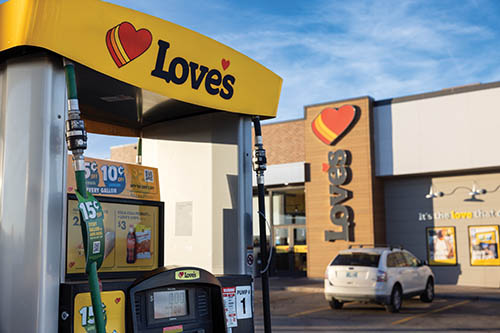— Interview by Katie Lee —
How Love’s Travel Stops grows its business by listening to customers and keeping their comfort and convenience top of mind.
When a company is run with love, it shows. Love’s Travel Stops is more than just the namesake of its founders, Tom and Judy Love, who opened a single filling station in 1964 in Watonga, Oklahoma. Today, this staple of the highway for over six decades remains family-owned and operated. What it has not done is remain complacent: In the modern era, Love’s is busy growing its fleet of 664 stores, renovating more than 50 locations, expanding customer services, and partnering with restaurants like Arby’s and Whataburger with in-store ordering kiosks. The company is also expanding EV charging offerings, upgrading signage and lighting to LED, and deploying high-efficiency HVAC filters. To learn more about this indispensable roadside icon, please read on. Editor Katie Lee recently interviewed Love’s senior director of corporate communications, Tracey Budz, for this story.
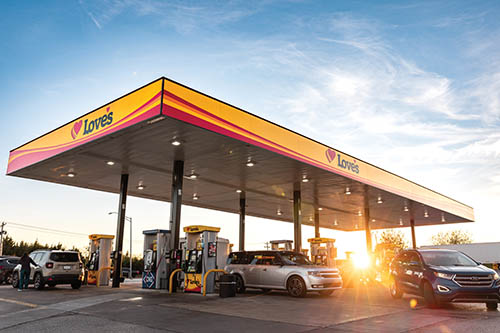
R&R: How many stores does Love’s operate today? What is the projected number of new openings in 2025 and 2026?
Tracey Budz: Love’s owns and operates 664 locations in 42 states. So far in 2025, Love’s has opened 10 new stores and plans to open six more before year’s end. The plan for new store openings in 2026 will be announced in the first quarter.
R&R: How big is your typical store prototype?
Budz: Love’s stores range from around 7,000 to more than 18,000 square feet. New Love’s travel stops have all the amenities Love’s is known for, including clean restrooms, a Mobile to Go Zone with today’s latest technologies, a dog park, Love’s Fresh Kitchen with salads, sandwiches, fresh fruit and more prepared on site daily. Sites also typically include one or two of Love’s quick-service restaurant partners.
R&R: Love’s is renovating 50 stores this year. What is involved in the strategic remodel initiative?
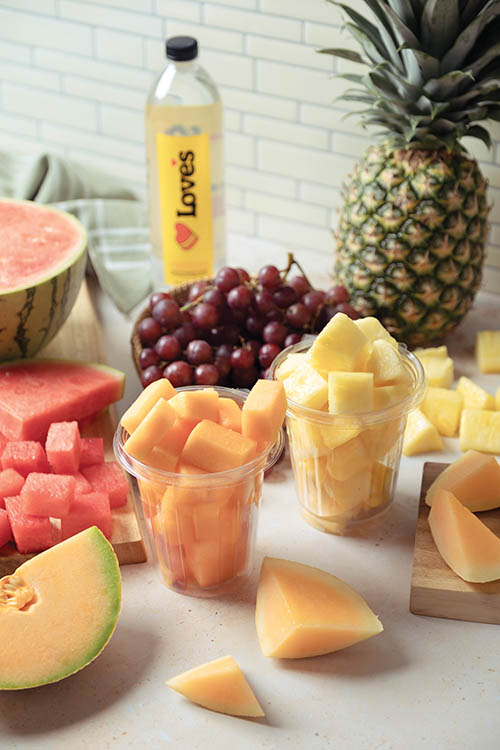
Budz: Though Love’s has always updated locations in some capacity, a formal program began in 2022, to strategically update aging locations. Most of the stores updated under this initiative remain open during the process where locations are made more modern with paint, updated floor plans, restrooms, showers and restaurant lobbies. So far, Love’s has opened eight remodeled locations in 2025 and with new locations and remodel efforts, more than half of Love’s network will be new or updated by 2035.
R&R: Love’s is expanding its truck wash services and RV hookups. It’s also adding ‘smart kiosks’ to enhance the customer dining experience. Tell me more about these upgrades and the feedback you’ve gotten so far.
Budz: Love’s continues to add convenient, safe locations to cater to the needs of RV customers, ensuring a top-tier experience. This year, Love’s surpassed the 100-location mark for locations with RV amenities. The established network of locations makes it easy for customers who need somewhere to stay on the way to their destination. Additionally, customers can use the Love’s Connect app to reserve a space, check-in and turn on utilities — something that sets us apart from competitors. Also, at select travel stops and truck care locations, Love’s Truck Washes service both trucks and RVs alike.
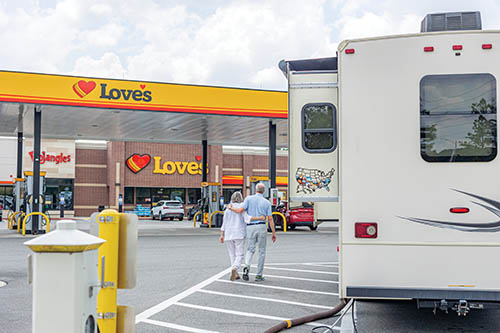
In store, Love’s offers innovative solutions to enhance the customer experience and operational efficiency in partnership with Bite, deploying intelligent kiosks in Love’s Arby’s restaurants across the country. Large, tablet-like touch screen kiosks allow customers to place their food orders quickly, and self-ordering improves order accuracy and reduces operational costs. Most importantly, this new technology is improving the overall dining experience for customers on the road.
This innovative technology is ADA-compliant and caters to a wide range of customers that make up the traveling public, including individuals with varying language needs and those who prefer a streamlined ordering process with minimal interaction. Kiosks support ordering in both English and Spanish, ensuring accessibility for a wider audience. The menus on the kiosks also offer images of all the items, helping people recognize options to make the ordering experience more approachable. Kiosks further enhance the ordering experience by suggesting limited time promotions and delivering recommendations.
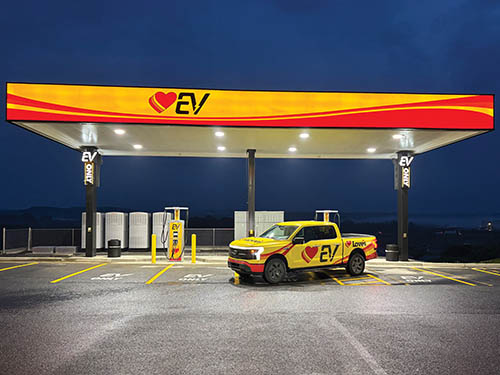
Feedback has been positive as guests have total control over their customizable order. With fewer touchpoints and more control, customers enjoy a seamless experience with fewer errors and a more personalized experience.
R&R: In June, Love’s hired Tim Langley-Hawthorne as its new chief technology officer (CTO). Tell me about his plans for new technology upgrades.
Budz: In this role, Tim Langley-Hawthorne reports to Love’s president, Shane Wharton, and is responsible for aligning technology with overall company strategy, driving product development and fostering technical innovation including the responsible deployment of artificial intelligence.
R&R: Love’s EV Fast Charging Network is also growing. How many chargers do you currently offer in how many stores and states? What is your goal for the next few years?
Budz: Love’s has been in the EV charging business since 2017. In 2020, Love’s began adding additional chargers at Love’s locations in California and currently has 85 total chargers throughout 30 locations across 11 states. Adding this amenity is a part of our focus on providing whatever type of fuel customers need and Love’s will continue to follow that strategy and listening to customers’ feedback.
R&R: Has Love’s Travel Stops always been headquartered, since its founding in 1964, in Oklahoma City? And is it still family owned and operated? Is family ownership rare in the modern convenience store industry? What benefits do you see from this business model?
Budz: Love’s was founded in 1964 by Tom and Judy Love, who opened a single filling station in Watonga, Oklahoma. The company has always been headquartered in Oklahoma City and remains family-owned and operated, with Tom and Judy’s children and grandchildren in various leadership roles in the company, including their sons Greg and Frank Love, who are co-CEOs and daughter, Jenny Love Meyer, who is the company’s executive vice president and chief culture officer.
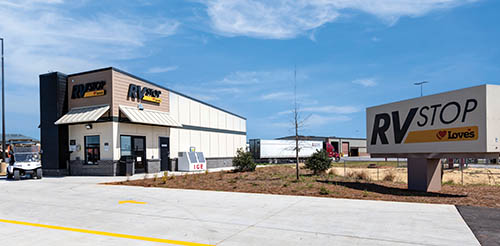
Being a family-owned and operated company is what sets Love’s apart from other major retailers and the atmosphere that creates ties into what makes people want to stay. Jenny Love Meyer started going on culture tours in 2022 to hear from store team members about what’s going well, what they might need help with, and new innovative ideas. Tom Love started doing store visits in the beginning, so this was a natural progression of those. Love’s had a positive reaction from employees about this and now it’s something Jenny does once a month. She’s joined local leadership teams and they visit five to six stores each day. The leaders run the location during the visit, so they have time to sit down with team members. Team members experience a lot during their shifts and more times than not they have the answers to challenges and new, innovative ideas to make Love’s better.
R&R: What are your biggest operational and/or maintenance related challenges? Describe how your maintenance department is organized. Do you handle maintenance in-house or outsource to third-party service providers?
Budz: Each location has a dedicated maintenance staff who also work with third-party service providers for activities like mowing, snow removal, weed spraying, etc.
R&R: Do you rely primarily on national vendors? Or a mixture of national and regional/local service providers?
Budz: Love’s leverages a national vendor network.
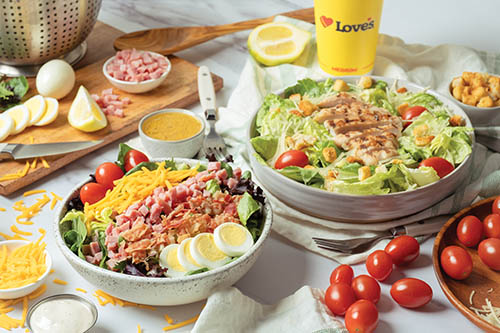
R&R: In addition to its network of EV charging, does Love’s have any “green” initiatives in place or in the works, such as how it maintains its stores, lighting retrofits or other energy-related upgrades, sustainable materials used in construction, etc.? What do you think is unique about maintaining your facilities as compared to other retailers?
Budz: Love’s has taken green initiatives such as converting high-rise signs to LED as well as the red heart, perimeter lighting and canopy lighting. Love’s also uses high-efficiency HVAC filters to improve air quality and lower energy costs. In addition, Love’s fuel-hauling fleet, Gemini, has in-cab camera systems for improved routing using GPS to lower fuel consumption and carbon footprint.
R&R: What do you think makes Love’s a “retailer to watch” in 2025 and beyond?
Budz: Love’s late founder, Tom Love, was an innovator from the start, selling deli and grocery items at some of the company’s first filling stations before that concept was available in much of the country. Love’s actively continues his legacy through innovation and growth and will continue to add new stores, update existing stores and add exciting new offerings. Love’s is continuously adding new private label food and merchandise offerings and expanding options at Love’s Fresh Kitchen, which offers salads, sandwiches, wraps, fruit and more prepared fresh daily in store. It is also adding new partnerships with quick-service restaurants. For example, this year, the company opened its first Buffalo Wild Wings GO location in Dodge City, Kansas, and has plans to add Whataburger to select stores in the near future.

